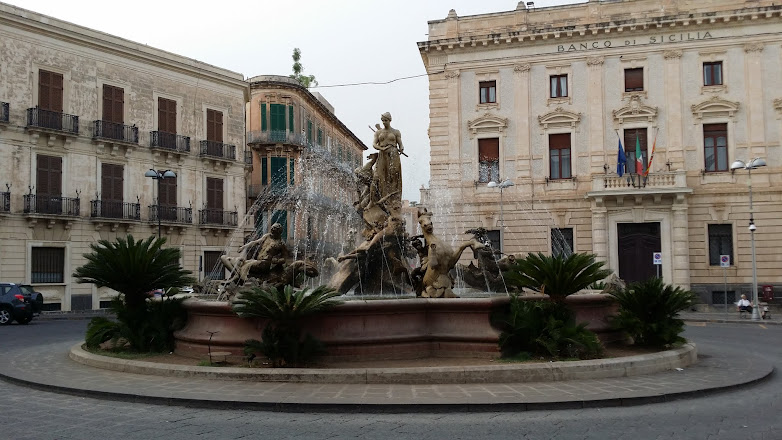Syracuse
After an excellent breakfast we set out for Syracuse, another drive across country. It was on these long drives that we noted the agricultural diversity of the island. It's quite hilly or even mountainous in places. It has similarities with parts of Spain that it seemed to resemble more than Italy. Perhaps it is its peoples' adherence to Siesta?
Sicilian Landscape - it's quite varied - note the prickly pear
The largest active volcano in Europe, Mount Etna, dominates the east of the island and the soil is volcanic and rich and highly productive. There are numerous vineyards many covered in agricultural netting and also vast areas of plastic greenhouses, crops range from corn to sugar cane.
A notable thing was the number of abandoned buildings. They dot the landscape, a legacy of the depopulation that the island suffered until recently when the population stabilised. We learned that whole villages lie abandoned but some buildings are now being snapped up by foreigners, particularly the English, for refurbishment as holiday or retirement homes. So now contemporary ruins compete with ancient ones for foreign attention.
Syracuse is another site of ancient ruins, this time both Greek and Roman. The Neapolis Archaeological Park ruins were an easy walk from our hotel, the Mercure. This is one of the largest and most diverse archaeological sites in the Mediterranean.
There is a large Greek amphitheatre. This is also the sight of numerous Roman period tombs, of the kind said to have been owned by Joseph of Arimathea and given to Jesus. These are like caves carved into the rock that were closed with a large stone. All these stones have since rolled away.
Greek amphitheatre - one of many tombs - sacred water - but don't drink!
Nearby is a remarkable cave that was named the Ear of Dionysius by Caravaggio because of its shape and amazing acoustics that allowed the Tyrant (Greek King) Dionysius I of Syracuse to spy on the conversations of his prisoners held nearby. Listening to prisoners without their knowledge seems a trivial thing these days.
The Ear of Dionysius
One of the largest sacrificial alters ever discovered is found nearby. Tyrant Hiero II of Syracuse (269 - 216 BCE) built it. It was a huge building in its day: 192 meters long by 23 meters wide within a columned portico. It was designed to facilitate the sacrifice of up to 450 oxen simultaneously to protect Syracuse from the wrath of the gods or to buy them off in blood. The concept reminded me of Herod's Second Temple in Jerusalem where special drains carried the blood of sacrificial lambs, goats and birds away.
As in Jerusalem, only the foundations remain. But in this case it wasn't the Romans who destroyed it, although they probably made off with the Greek statues. All the easily removed blocks, columns, access ramps, and so on were plundered by the Spanish in the 16th century for stone to fortify Ortygia.
The remains of the Altar of Hiero II
It is thought to have resembled the Pergamon Alta (reconstructed in the Pergamon Museum in Berlin)
The downside to the otherwise comfortable, and recommended, Mercure hotel was that the historic and interesting island of Ortygia is several kilometres away through some pretty seedy suburbs. Walking around near the station was the first time we'd seen people who looked less than prosperous. You can walk all the way to Ortygia but its more time productive to take a cab or public transport - or to drive your Jeep and compete for very limited parking by the waterside as we did.
Ortygia features an upmarket shopping precinct with the usual clothing and luxury item chains selling fashion goods, in addition to the best restaurants, hotels and so on. It is also the site of the largest Greek Temple in Sicily, The Temple of Apollo, but it's not in good condition so you can look but don't touch. For some reason I didn't bother to photograph it probably because there's not much to see. No one in Ortygia looked poor, until we took a shortcut through the back streets to and from the car.
 |
|
Around Ortygia
